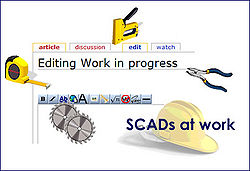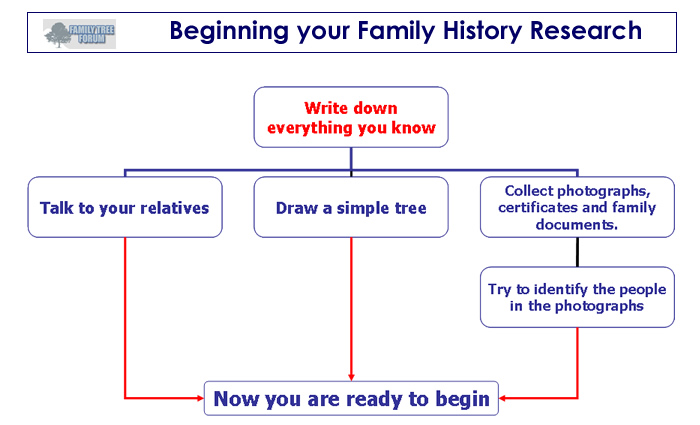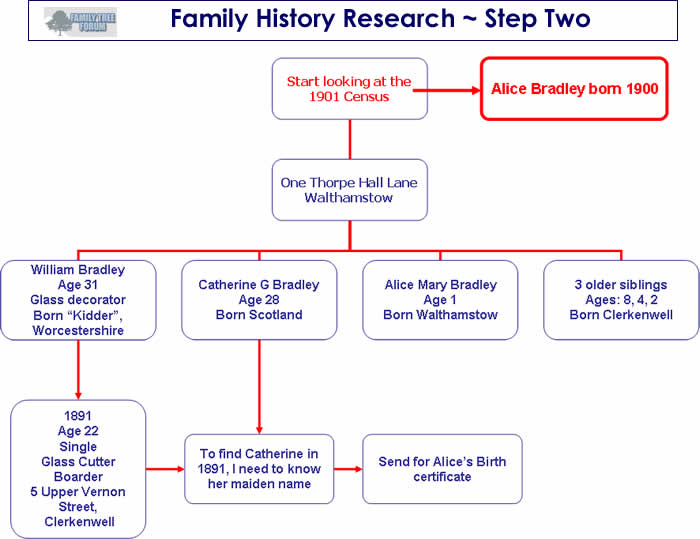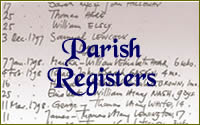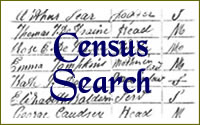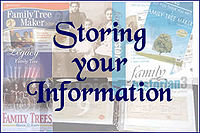Creating Your Family Tree
Contents
- 1 Beginning Your Research
- 2 Step One ~ Talk To Your Relatives
- 3 Step Two ~ Going Back Before 1900
- 4 Step Three ~ How Do You Know They "Belong" In Your Tree?
- 5 Step Four ~ Before Civil Registration
- 6 Step Five ~ Finding Those Names
- 7 Step Six ~ Storing Your new Found information
- 8 Step Seven ~ Sorting Out Those Relationships ...
- 9 Step Eight ~ Taking Your Research Further
- 10 Step Nine ~ Contacting Other Researchers
- 11 Step Ten ~ Asking For Help
- 12 Quick Hints and Tips
Beginning Your Research
Before you can start constructing your tree, you need to find the branches and twigs to populate it. This page will give you advice on how to go about it and where to find the information, together with hints and tips on deciding whether they are "yours", using The Wiki pages and external links.
Step One ~ Talk To Your Relatives
The first thing to do when you’re starting out is to write down everything you know about your family – names, dates and places of birth, marriages & deaths etc. Ask your relatives for help, especially the older generation, they’re usually a mine of information and stories. Perhaps take a tape recorder along with you to record what they say. Collect together as many old photos, certificates and other family documents you can find. Try to find out the identities of the people in these photos.
Once you’ve collected all of this information and drawn up a simple tree linking them all together, you’re now ready to trace your family back further.
- Downloadable Blank Charts Seven different layouts for recording your direct line.
- How to store it all... Gives many different ideas on how to organise your information.
Step Two ~ Going Back Before 1900
You may be lucky enough to have enough information to take you back to 1901 and beyond. The 1901 census is the latest one which is available to family researchers in its entirety. You can search the census from the comfort of your computer chair through subscription websites such as Ancestry.
There are also other sites which you can find on Online Research.
Once you have found your known relative, look to see who’s living in the same household – brothers, sisters, parents or even grandparents. Census returns including names, ages and places of birth were taken every 10 years from 1841, so online you have access to 60 years worth of census records. By tracing your family back through the census returns it is possible to take your family back to ancestors born in the 1700’s.
Family History Research ~ Step Two This page extends the search back to 1841.
Write down all of your new found information. It would also be a good idea to save the census images you have found to a file on your computer.
The Census Search pages will give you information about Census returns and advice for searching them.
A Visual Guide to Tracking down your ancestors before 1900.
Step Three ~ How Do You Know They "Belong" In Your Tree?
What you have now is the framework of your family tree. Some of this information may be wrong, perhaps Granny’s memory is failing, or that the information recorded on the census returns is incorrect.
To confirm these connections you will need to obtain your ancestor’s birth, marriage and death certificates. These can be obtained online from the General Record Office (GRO) (the General Register Office of Scotland (GROS) in Scotland) or through the local register office where the event was registered. It should cost you around £7 per certificate, which can work out quite expensive.
However it is essential that you confirm connections this way, otherwise you can end up tracing the wrong ancestors.
If you weren’t able to trace your family back to the time of the 1901 census, then you can do this through certificates.
Birth, marriage & death certificates in England and Wales are available from 1st July 1837 (and from 1855 in Scotland) when civil registration was first introduced.
These pages will help you find out All About Certificates and how to go about obtaining them.
Step Four ~ Before Civil Registration
text here
Step Five ~ Finding Those Names
Even in Victorian times many people could not read or write and therefore did not know how their name was spelt. Together with regional accents the vicar or registrar had no alternative but to record the name which they had heard spoken. If you are having difficulty finding a given surname, then think of an alternative spelling or how it would sound spoken in a local accent.
The online census returns are an excellent resource for family researchers. However to enable them to be searchable they have to be what’s called transcribed. Each sheet of the original handwritten return is recorded onto a computer database by a transcriber and therefore it’s quite understandable that mistakes can be made. For tips on how to search the census returns go to Census Search
You can imagine what a mammoth task it must have been compiling all of this information on census night. Very often you will find christian names abbreviated, for example Jas for James or Fredk for Frederick. To find more christian name abbreviations go to Common Forename Abbreviations.
Today we name our children according to our own personal choice. Our ancestors followed naming traditions. To find out more go to Naming Patterns
You must also bear in mind that your ancestors may not be using the name which they were registered with. If they had a first and a second christian name, then they may have been known as their second name. Also they may be recorded under a nickname such as Jack for John or James, or Nancy for Anne, Ann or Hannah.
For more information about christian names and surnames go to Finding those names
Step Six ~ Storing Your new Found information
As soon as you start researching your family you will begin to amass a large amount of information and notes, certificates and other family documents, together with prints of census images, civil registration and parish register entries, and other information which you have found.
It’s a good idea fairly early on to decide how you are going to organise and store it all, otherwise you can quite easily end up with an unmanageable paper mountain.
Many researchers store all of their paperwork in ring binders, using a different one for each family. This can then be divided up into separate sections for the different types of information you have gathered. You may decide to store items in plastic wallets within the binder, however make sure that these are acid free otherwise they will damage items over time. You can buy special certificate binders with acid free sleeves online from companies such as:
There are numerous family tree software packages available to buy at varying prices. Some are even available as a free download:
- Personal Ancestral File (PAF)
By using a software package your information is held in a manageable and easy to access format. At the click of your computer mouse you can view all of the details you hold on a given person in your tree and clearly see their relationships within it. Many packages have excellent graphics enabling you to create professional looking family tree diagrams.
You may wish to scan your family photos, these images can then be held in a file on your computer. Some software packages allow you to link these photographs to individuals in your tree.
All of the information which you have input into your family tree software is stored as a file on your hard drive of your computer. This file can then be uploaded and stored online on sites such as:
Unfortunately if your hard drive was to fail, as they eventually do, all of your information held in its files will be lost. It is therefore advisable to regularly back up to disc and keep this in a safe place.
Most family researchers use a combination of both computer and paper based storage. Whatever system you decide to use is entirely up to you, however make sure that’s it’s both safe and secure otherwise all of your hard work will be lost.
Step Seven ~ Sorting Out Those Relationships ...
Who is your 5th cousin twice removed? Can first cousins marry? Can a man marry his wife's sister? Is a man allowed to marry his great-grandmother in Scotland?
As you research your family you will not only find your direct line ancestors, but also their brothers and sisters as well. The siblings of your grandparents are your great aunts and uncles, and of your great grandparents your great great aunts and uncles, and so on.
You may wish to research these branches of your family to discover their descendants who are your cousins. Those who share your grandparents are your first cousins and those who share the same great grandparents as you are your second cousins, and again this continues. The children of your first cousins are your first cousins once removed. Their grandchildren will be your first cousin twice removed and so on. The same will apply to your second, third etc cousins.
Most family tree software packages will work out these relationships for you.
To read more go to:
Step Eight ~ Taking Your Research Further
text here
Step Nine ~ Contacting Other Researchers
Genealogy is an increasingly popular hobby thanks mainly to the numerous television programmes on the subject. It is possible that other people are researching the same ancestors as you, so it’s a good idea to make contact with them to share information, certificates and even photographs. You will be amazed to see how much family resemblance you can see in a photograph of a distant relative. Perhaps your new found contact may be able to name the unidentified people in your photographs.
The Surname Directory lists the surnames and their localities, which members of this site are researching.
You can also upload a GEDCOM of your family tree to this site’s Database and search to see if other members are researching the same individuals as you.
Other sites you can use for making contacts are Genes Reunited, Cousins.com Lost Cousins and Curious Fox
One word of advice though. Don’t take the information received from others at face value. You do not know how thorough they have been in their research. Therefore it is advisable to confirm this information yourself before you put it all onto your tree.
Step Ten ~ Asking For Help
Everybody researching their family gets stuck at some point, it’s commonly known as a brick wall.
If this happens to you, then just post a thread up onto the Research Board of this site and there should be a helpful member around willing to offer their assistance.
If you have a photograph which you require dating or advice on, then you can post this in a thread on the Family Tree Photos board on this site.
Advice on how to put photographs on to a thread can be found on How to use Photobucket
Quick Hints and Tips
- Once you find the census images it’s a good idea to download them to your computer and keep them in a file all together.
Your tree is looking good now, perhaps it’s time to revisit your relatives to jog some memories and hopefully get some more information and put some more names to faces in those old photos......
